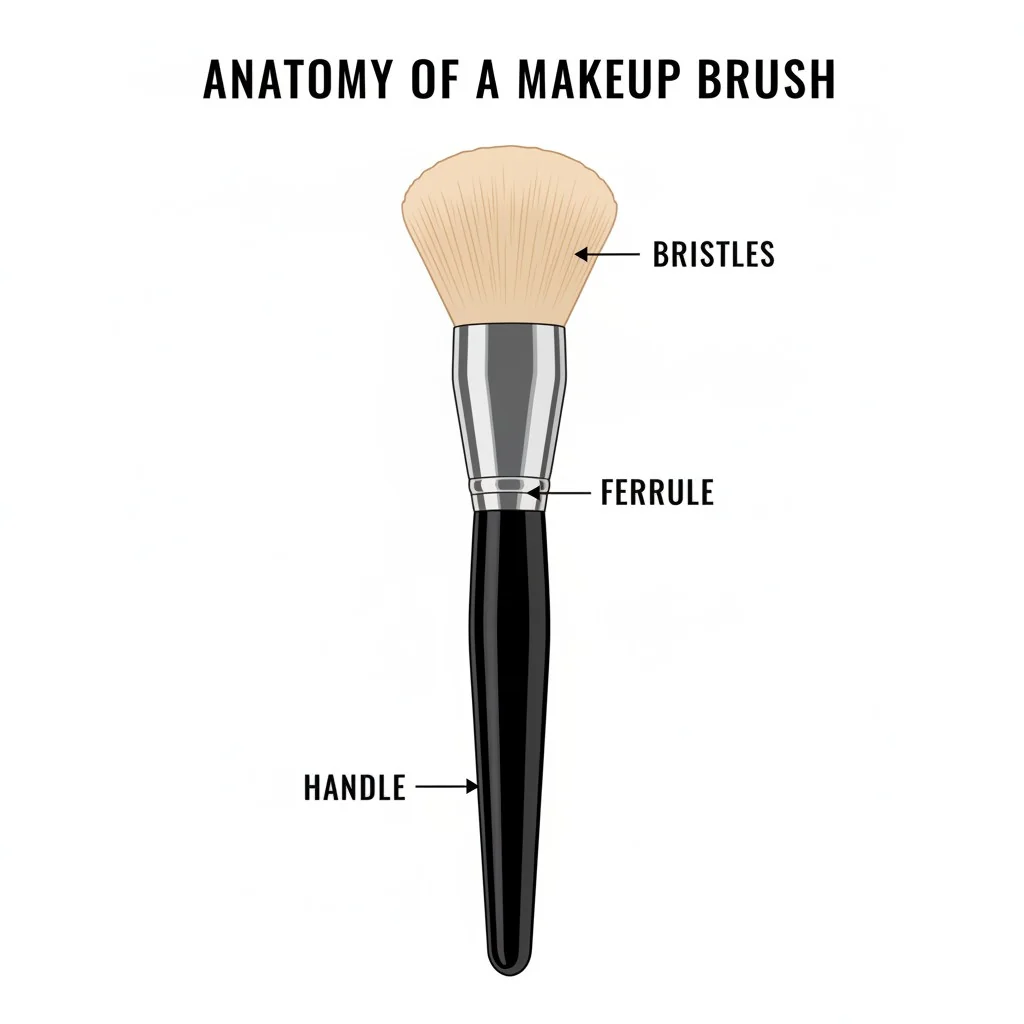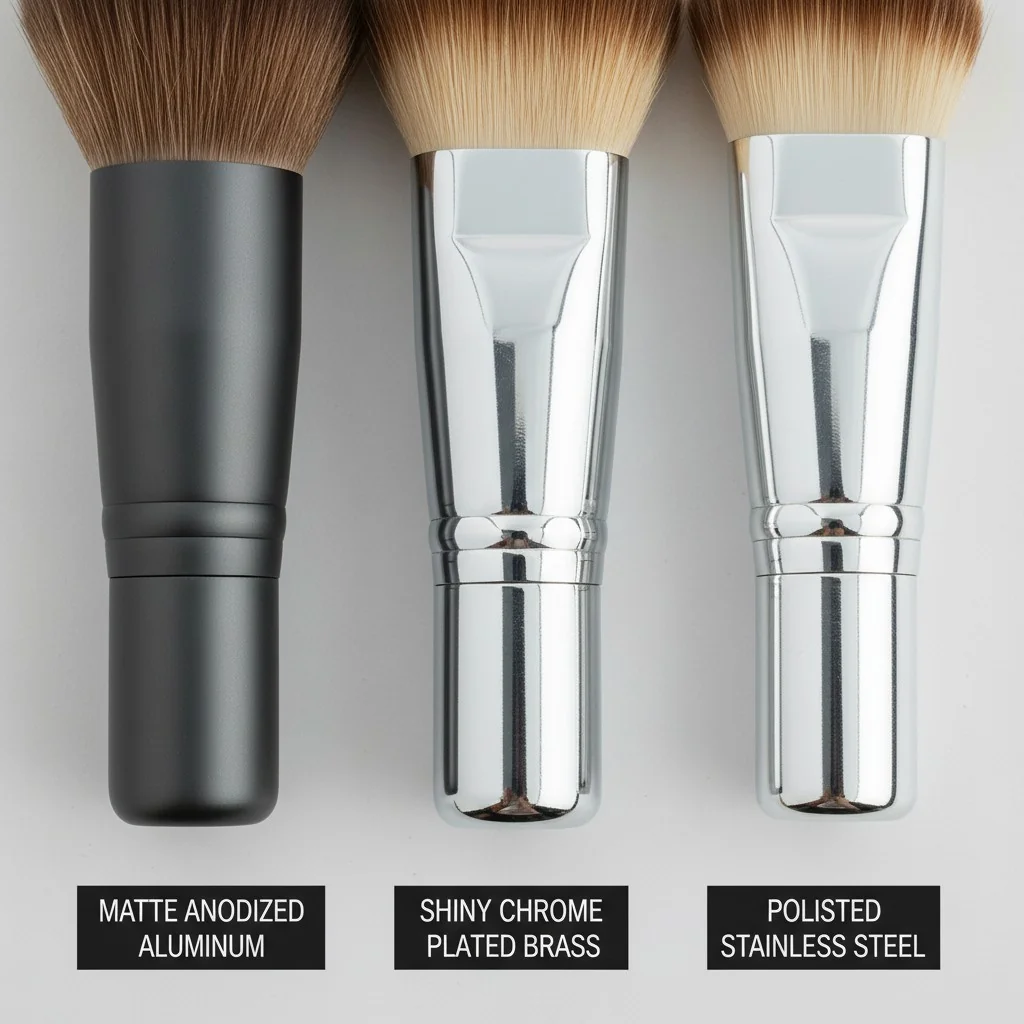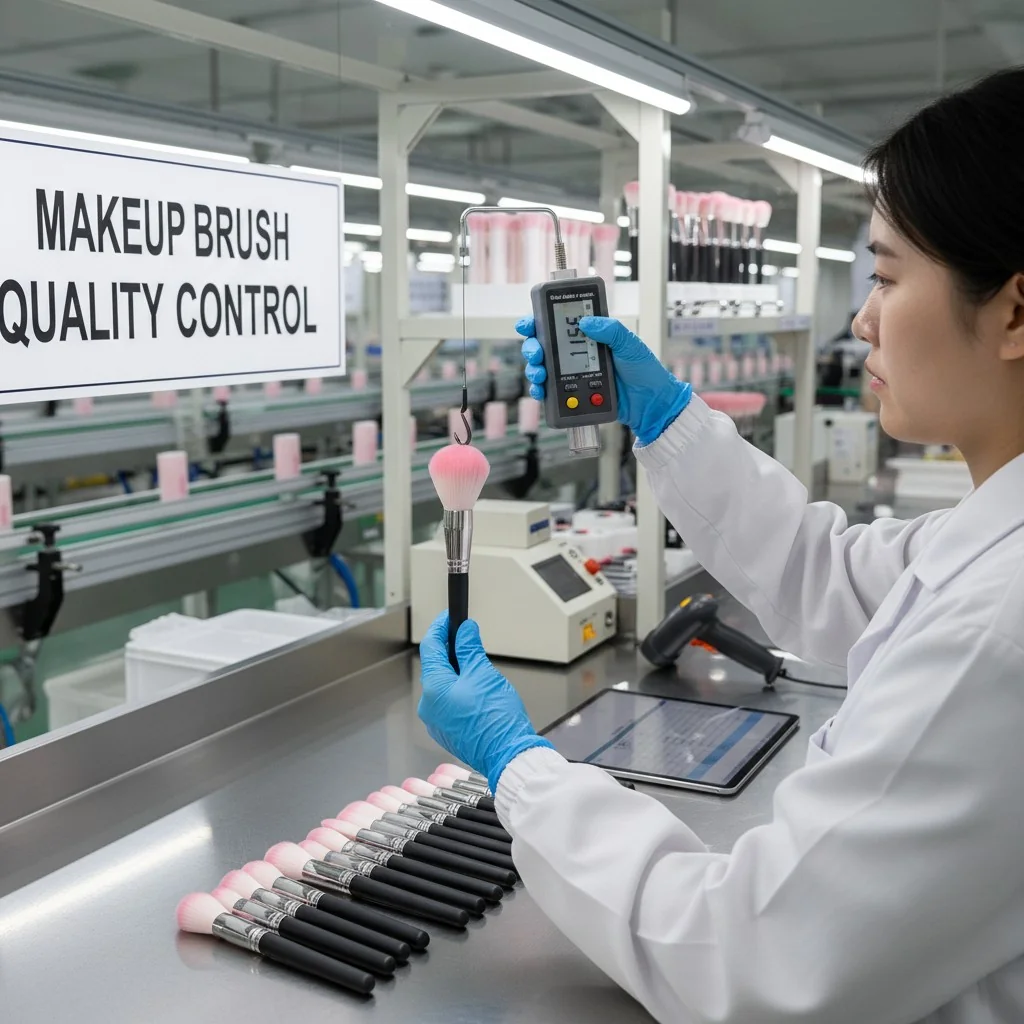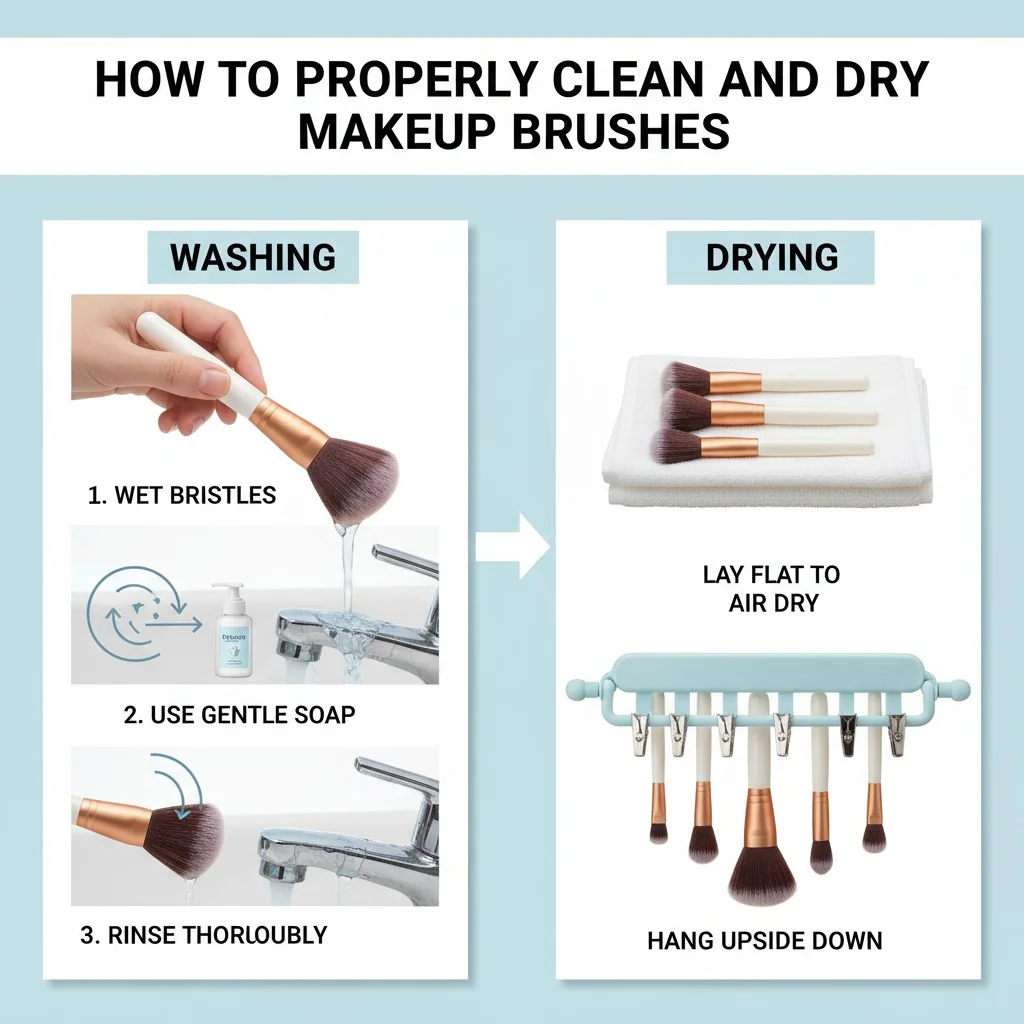Your brand’s reputation is on the line with every brush. A wobbly head or shedding bristles can lead to bad reviews. The solution is focusing on one small, overlooked part.
The metal sleeve on a makeup brush is called the ferrule1. It anchors the bristles to the handle, usually made from anodized aluminum or plated brass. It is secured with strong epoxy and a calibrated double crimp to ensure durability and prevent shedding.
When I first started working on the factory floor, I saw firsthand where brushes fail. It wasn’t usually the bristles. Most customer complaints2—shedding, wobbly heads, even rust marks—traced back to the ferrule. This small metal part is the true anchor of a quality brush. Getting the ferrule right means choosing the right metal, finish, adhesive, and assembly process. From my experience, engineering the ferrule correctly prevents over 90% of these common quality issues. For brand founders, understanding these details is not just about manufacturing; it’s about building a product that creates happy, loyal customers.
The bristles are the most common reason for makeup brush failure.False
From factory experience, the majority of post-sale complaints like shedding and wobbly heads trace back to decisions made about the ferrule assembly, not the bristles themselves.
Over 90% of common customer complaints can be prevented by correctly engineering the ferrule.True
Choosing the right ferrule metal, thickness, finish, epoxy, and crimping process solves the root cause of shedding, loose heads, and rust in normal consumer use.
Ferrule fundamentals: metals, finishes, wall thickness—and why do they matter?
Choosing the wrong ferrule metal can lead to dents, rust, and a cheap feel. This undermines a premium brand’s image. The key is knowing the trade-offs between different materials.
A ferrule’s material, finish, and wall thickness determine its durability, corrosion resistance, and weight. Aluminum is lightweight and cost-effective, plated brass3 offers a premium feel and dent resistance, while stainless steel provides the best protection against rust for high-performance lines.
The ferrule does more than just hold the parts together; it communicates quality. The weight, finish, and sturdiness are the first things a customer notices. When you’re developing a brush line, the choice of metal is a critical decision that impacts cost, performance, and brand perception. For example, a wall thickness below 0.30 mm might save a fraction of a cent, but it can easily deform during the crimping process. This creates tiny gaps that lead to a wobbly head later on.
Comparing Ferrule Materials
Here is a simple breakdown I use with clients to help them decide:
| Attribute | Aluminum Ferrule | Brass Ferrule | Stainless Ferrule |
|---|---|---|---|
| Typical finish | Anodized (5–25 µm) | Nickel/Chrome plated | Polished/Passivated |
| Wall thickness (mass market) | 0.30–0.45 mm | 0.30–0.40 mm | 0.25–0.35 mm |
| corrosion resistance4 | Good with anodize | Very good with plating | Excellent (no plating needed) |
| Dent resistance | Moderate | High | High |
| Cost | Low | Medium–High | High |
| Weight (feel) | Light | Heavier, premium | Medium–heavy |
Aluminum is great for entry-level or mid-tier lines where cost and lightweight design are important. For premium brands, the extra weight and high dent resistance of brass with nickel/chrome plating feel more luxurious. Stainless steel is the ultimate choice if your top claim is anti-rust performance, but its cost is higher.
Hot-melt glue is a reliable alternative to epoxy for securing brush heads.False
Hot-melt glue has much lower resistance to heat and solvents compared to two-part epoxy. It can fail when a brush is cleaned with alcohol-based solutions or left in a hot car.
A double crimp is always better than a single crimp.True
When properly calibrated, a double crimp provides superior mechanical strength, securing both the hair knot and the handle. This significantly reduces the chances of a wobbly or twisting brush head.
OEM specs and QC: how do you test for pull strength, salt-spray, and visual finish?
You approved a perfect "golden sample," but the final production run is full of inconsistencies. This is a common nightmare for brand owners. You can avoid it with clear, measurable QC standards.
To ensure consistent quality, you must define clear OEM specifications for your factory. This includes performance tests like pull strength for shedding, salt-spray tests for rust resistance, and drop tests for durability, along with strict visual grading for the finish.
Trust is good, but testing is better. As a brand owner, you can’t be on the factory floor every day. That’s why you need to establish a clear Quality Control (QC) plan with your manufacturer. This plan turns subjective ideas like "good quality" into objective, measurable data. It acts as a contract that ensures every brush in your bulk order meets the same standard as the sample you approved. This is how you protect your brand and your investment.
Key Performance Tests
Here are the three most important tests I recommend for ferrules:
- Axial pull strength test7: We use a machine to pull the brush head straight off the handle. This measures the strength of the epoxy bond and crimp. A good target is ≥8–12 kilograms of force (kgf) for a face brush and ≥5–8 kgf for a smaller eye brush.
- salt-spray test8: This is for plated ferrules, like chrome on brass. The brush is placed in a chamber with a salt mist to accelerate corrosion. A good spec is to show no rust after 24 to 48 hours, depending on your anti-rust claims.
- Drop Test: A simple but effective test where brushes are dropped from a standard height onto a hard surface to check for chipping, dents, or loosening of the head.
Setting Acceptance Criteria
We also agree on visual standards for the finish—no pits, bubbles, scratches, or color variations. All of these tests and standards should be part of a sampling plan, like ANSI/ASQ Z1.4, which defines how many brushes to inspect from a batch to ensure the entire order meets your quality level.
Visual inspection is enough to guarantee a durable brush.False
Many critical failures, like a weak epoxy bond or an improper crimp, are invisible. Performance tests like the pull-strength test are necessary to find these hidden defects before they reach your customers.
A salt-spray test is a standard method to verify the corrosion resistance of plated ferrules.True
This accelerated lab test simulates long-term exposure to humidity and corrosive environments. It provides objective data to back up any anti-rust marketing claims for your brushes.
Preventing customer complaints: how do you design for durability and guide your customers?
Your customers complain that their brushes are rusting or falling apart after just a few washes. These negative reviews can sink a product. The solution is a two-part strategy: smart design and customer education.
Prevent complaints by first choosing rust-resistant materials like high-quality plated brass or stainless steel. Then, provide clear cleaning guidelines that instruct customers to avoid soaking the ferrule and to dry brushes with the bristles pointing down to protect the internal glue.
The best way to handle customer complaints is to prevent them from ever happening. This starts in the design phase and continues with the information you provide to your customers. As a brand, you can’t control how every customer uses your product, but you can make your brushes more resilient and guide users toward best practices. This shows that you care about the longevity of your products and builds trust.
Engineering for Longevity
The technical choices we discussed earlier directly impact customer satisfaction.
- Preventing Rust: If you want to market your brushes as long-lasting, don’t use raw, uncoated brass. Specify a quality nickel/chrome plating system. For the ultimate anti-rust guarantee, choose stainless steel.
- Preventing Shedding: Use two-part epoxy, ensure a proper fit between the hair knot and ferrule, and specify a double crimp. These steps create a bond that can withstand repeated washing.
Educating the End-User
Your packaging or website is the perfect place to include a simple "Brush Care" guide. I always advise my clients to include these three points:
- When washing, try to keep water and cleansers away from the area where the ferrule meets the handle.
- Never soak the entire brush in water. This allows water to seep inside the ferrule and weaken the epoxy over time.
- After washing, gently squeeze out excess water and lay the brush flat or hang it with the bristles pointing down to dry. This prevents water from draining into the ferrule.
These simple instructions can dramatically extend the life of a brush and prevent the most common user-created failures.
It's safe to soak makeup brushes in hot water for a deep clean.False
Soaking allows water to get inside the ferrule, which can break down the epoxy adhesive. Hot water accelerates this process, leading to a wobbly head and shedding bristles.
Drying brushes with the bristles pointing down helps protect the glue inside the ferrule.True
Gravity pulls water away from the ferrule opening, preventing it from seeping in and weakening the epoxy bond. This simple habit significantly increases the lifespan of a brush.
Conclusion
The ferrule is the core of a durable brush. By focusing on its material, assembly, and testing, you can build products that last and earn your customers’ trust and loyalty.
References
-
Understanding the ferrule’s role is crucial for ensuring the quality and durability of makeup brushes. ↩
-
Understanding common customer complaints helps brands design better products and improve customer satisfaction. ↩
-
Plated brass provides a premium feel and high dent resistance, enhancing the overall quality of makeup brushes. ↩
-
Corrosion resistance is vital for maintaining the appearance and functionality of makeup brushes over time. ↩
-
Double crimping secures the brush head and handle, significantly improving stability and durability. ↩
-
Epoxy provides a strong bond and resistance to water, ensuring the longevity of makeup brushes. ↩
-
The pull strength test measures the durability of the bond between the ferrule and brush head, ensuring quality. ↩
-
The salt-spray test evaluates the rust resistance of ferrules, providing assurance of quality to consumers. ↩






